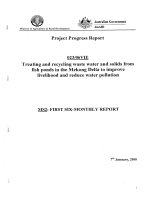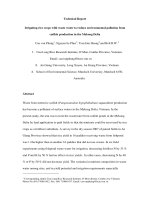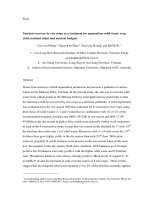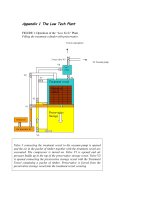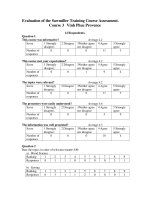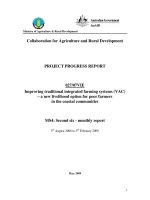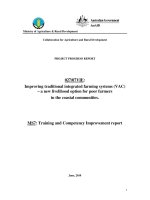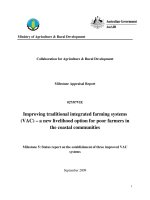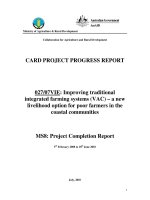Báo cáo khoa học nông nghiệp " The development and implementation of new appropriate technologies for improving goat production and increasing small-holder income in the central region of Vietnam - MS2 " potx
Bạn đang xem bản rút gọn của tài liệu. Xem và tải ngay bản đầy đủ của tài liệu tại đây (78.94 KB, 12 trang )
Ministry of Agriculture & Rural Development
Project Progress Report
009/VIE05
The development and implementation of new
appropriate technologies for improving goat
production and increasing small-holder income
in the central region of Vietnam
MS2: FIRST SIX-MONTHLY REPORT
16/08/2006
1. Institute Information
Project Number & Name
The development and implementation of new
appropriate technologies for improving goat
production and increasing small-holder income in
the central region of Vietnam (009/VIE05)
Vietnamese Institution
Goat and Rabbit Research Centre (GRRC), NIAH,
MARD
Vietnamese Project Team Leader
Assoc. Prof. Dr Dinh Van Binh
Contact Email
Telephone: 8434838341
Fax: 8434838889 Organisation: Goat and Rabbit
Research Centre Email:
Australian Organisation
The University of Queensland
Australian Personnel
Dr Barry W. Norton
Contact Email
Telephone: 61733651102
61732890260 (AH) Position: Honorary Research
Consultant Fax: 61732890103 Organisation: The
University of Queensland
Email:
Project Abstract
The development of goat production systems in Vietnam has been strongly promoted
by the Vietnamese government through the establishment and support for the Goat and
Rabbit Research Centre at Son Tay in the north of Vietnam. The initiatives developed
at this centre through both national and international R&D programs have been
successfully implemented on local farms in the north, and both the national and
provincial governments wish now to promote similar schemes in central and southern
Vietnam. While many of the technologies exist, the expertise and funding to apply
these to small holder farmers are limited. The proposed 3 year project aims to identify
the limitations to improving goat productivity and profitability on selected farms in
Ninh Thuan, Binh Thuan and Lam Dong provinces; and to train local Department of
Agriculture and Rural Development (DARD) staff in goat production systems and in
the application of appropriate technologies (improved housing, disease control,
improved feed supply and quality, introduction of Bachthao and Boer bucks of proven
genetic merit). In this way the existing limitations to improving productivity will be
overcome, thereby improving the income and well-being of farming communities in
these areas
2. Executive Summary
The following report presents information on the initiation of activities for the CARD
project The improvement and implementation of new appropriate technologies for
improving goat production and increasing small-holder income in the central region
of Vietnam (009/05VIE) in Vietnam during the period January to June 2006. Funding
was first provided following the official signing of the project documents in late March
2006, permitting the distribution of funds to Vietnam, and planning for the various
activities listed in the Project Design Document (PDD). The project was practically
initiated by the visit of Dr Norton to Vietnam (April 19 – May 4 2006) when it was
decided that the working title of the project will be “Vietnam-Australia Goat
Improvement Project (2006-2009)”, and this title will be used in all official future
reports. At this time, discussions were held in Vietnam with Dr Dinh Van Binh, Director
of GRRC and joint Director of the project and Dr Nguyen Thi Mui, Project Consultant on
matters of project management, including the signing of a MOA between GRRC and UQ
as a means of confirming the collaborative responsibilities of the two parties. Matters of
funds disbursal, Board structure and planning for the delivery and reporting of activities
were also discussed. In the first week of the visit, a training course for Department of
Agriculture and Rural Development (DARD) staff (14) from Binh Thuan (4 staff), Ninh
Thuan (6 staff) and Lam Dong (4 staff) provinces was completed. During this time,
information was presented on all aspects of goat production and a questionnaire
developed for surveying goat farmers in these areas. In the following week, 27 farms
were selected in these provinces (9 Binh Thuan, 15 Ninh Thuan, 3 Lam Dong), and
surveys conducted during this time. The results of this survey are currently being entered
into a data base for analysis, and will form the basis for evaluating the impact of the
project over 2 year period. In May-June, Dr Mui and the team from GRRC returned to the
farms surveyed and initiated the introduction of the proposed new technologies
(improved housing for goats, application of vaccines and medicines to control disease
and establishment of forage plots for future use as feed in the dry season. DARD staff are
currently maintaining contact with these farmers, and solving problems as they arise.
Details of these activities are provided below. It may be concluded that excellent
progress has been made in this first 6 month period of this project, and despite the late
start, and some difficulties associated with the arrival of the wet season, the basic project
structure (training, survey, initiation of activities on afrm) has been established.
The development of goat production systems in Vietnam has been strongly promoted by
the Vietnamese government through the establishment and support for the Goat and
Rabbit Research Centre at Son Tay in the north of Vietnam. The initiatives developed at
this centre through both national and international R&D programs have been successfully
implemented on local farms in the north, and both the national and provincial
governments wish now to promote similar schemes in central and southern Vietnam.
While many of the technologies exist, the expertise and funding to apply these to small
holder farmers are limited. The proposed 3 year project aims to identify the limitations to
improving goat productivity and profitability on selected farms in Ninh Thuan, Binh
Thuan and Lam Dong provinces; and to train local Department of Agriculture and Rural
Development (DARD) staff, participating and other local farmers in goat production
systems and in the application of new and appropriate technologies (improved housing,
disease control, improved feed supply and quality, introduction of Bachthao bucks of
proven genetic merit). In this way the existing limitations to improving productivity will
be overcome, thereby improving the income and well-being of farming communities in
these areas.
The following report (January-June 2006) describes the progress made to date, a visit by
Dr Norton to Vietnam (15 April- 4 May) and involvement of the team with the conduct of
a training coursefor DARD officers at GRRC, development and application of a
questionnaire to 27 farms (farmers) in Ninh Thuan, Binh Thuan and Lam Dong
provinces, the provision of improved goat housing, vaccines and medicines and the
development of forage banks on each farm. Planning for the next 6 months was also
undertaken at this time.
3. Introduction & Background
Goat production in Vietnam has rapidly expanded in the north with the introduction of
new knowledge for disease control, feeding management and the introduction and
selection of both local (Co, Bachthao) and exotic (Boer, Saanen, Jumnapari etc) breeds of
goats to village systems. These initiatives have been lead by the Goat and Rabbit
Research Centre (GRRC) at Bavi, from which an expanding milking and meat goat
industry is being developed. While goat meat is not a common commodity in the markets
in Vietnam, economic returns for goat farming are high and are attracting many farmers
to add goats to their farming enterprises. Goats are particularly important for poor
farmers, providing good returns for little investment. The project proposal which has
been developed and successfully funded by AusAID under the CARD program was
specifically aimed at providing poor farmers in the central provinces of Vietnam (Ninh
Thuan, Binh Thuan, Lam Dong) with some of the new technologies which have been
developed by GRRC in the north. This aim is reflected in the project title “The
improvement and implementation of new appropriate technologies for improving goat
production and increasing small-holder income in the central region of Vietnam”. This
is a program which includes elements of farm survey, strategic planning for improving
health and nutrition of goats, as well as training of key farmers and Department of
Agriculture and Rural Development (DARD) staff in these new technologies. Extension
of these activities to the wider community will be achieved by conducting field
days/workshops for local farmers using demonstration farms. The following report
describes the outcomes of the first official visit to Vietnam during which time strategies
for project implementation and management were developed, as well as recording the
progress made to date in achieving project objectives and plans for activities the coming
six-monthly period.
Objectives and Outputs of Project: The Project has proposed a list of 7 objectives
which it plans to achieve over the 3 year period 2006 to 2009. These are as follows:
1. Identification and characterisation of target farms
2. Training and Information Dissemination
3. Provision of improved housing and health care for goats
4. Improve the availability and quality of feeds and forages for goats
5. Provide local and introduced Bach Thao bucks of proven genetic merit for
breeding
6. Economic evaluation of impact of new technologies on goat productivity
7. Support for pilot meat processing facilities at the Ninh Hai Goat Research Centre,
Ninh Thuan
Within each objective there are a series of activities associated with expected outputs,
and these plans are shown in Table 10, (Project Logframe) which is the same table
shown as Table 3.1 in the Final Project Design document approved by CARD for
implementation. With the exception of Objective 7, parts or all of the above objectives
have been achieved in this first 6 month period.
Approach and Methodology
The information provided below is the same as that presented in the Project document
and agreed to as appropriate to the objectives outlines above.
General approach. The project will be located in the Ninh Thuan, Binh Thuan and Lam
Dong provinces which are located in the south central coast of Vietnam, 334 km from Ho
Chi Minh city and some 1400 km from Hanoi. The local people are mainly Kinh, Cham,
Ede and are amongst the poorest in Vietnam (US$45-65 income per annum). The
traditional farming systems vary from rice cropping in the river deltas in Ninh Thuan to
upland farming systems based on cassava, root crops, fruit and forest trees and livestock.
Goat numbers in 2004 in Ninh Thuan, Binh Thuan and Lam Dong were estimated to be
93,930; 35,275 and 9309 respectively. Goats are largely managed by women and
children. Income from livestock forms 22 to 25% of total income from agricultural
production in this region. Three broad categories of farming systems (lowland high
rainfall, upland low rainfall and highland high rainfall) have been selected. The plan is to
develop 27 farms (15 in Ninh Thuan, 9 in Binh Thuan, 3 in Lam Dong) by firstly
surveying each enterprise and then providing new technologies (housing, health care,
nutrition, breeding bucks) as indicated. These participating farmers will be also trained in
a short course at GRRC and then on farm by DARD officers in the implementation of
these management skills. In each province, 2 farms will be selected as demonstration
farms which will be used to train other farmers in these techniques and as model of
progressive goat production systems. The selected farmers will have experience of goat
production, having between 50 and 100 goats and generally sufficient land to grow the
required forages. This holistic approach to the introduction of new technologies is
preferred to a more fragmented approach where only specific interventions (eg disease
control only) are made. This approach to development has been successfully applied in
north Vietnam and is expected to provide a rapid improvement in productivity in similar
systems in central Vietnam. An important new initiative for this project is the support for
a pilot meat processing plant at the new goat research centre to be built at Ninh Hai in
Ninh Thuan.
Staff and institutional gaps will be addressed by a comprehensive training program,
firstly, by training DARD staff at GRRC and linking them with specialist GRRC
counterparts, and secondly by using the trained DARD staff to train district officers,
participating farmers and the local communities through the dissemination of information
through written materials, workshops and demonstrations. This approach will build
capacity in Australian collaborators, GRRC staff and farmers to work as inter-
disciplinary and inter-institutional teams, and foster a more holistic approach to
improving agricultural and animal production in these poor villages in central Vietnam.
The Australian partner contribution will be largely through the active participation of Dr
Norton in all matters relating to the development and introduction of the new
technologies, and will be complemented by the visit of 5 senior Vietnamese staff to
Australia, where they will visit goat production farms and processing facilities for meat
and milk, as well as inspecting a range of fodder conservation systems.
The training programs will have as a central aim the preparation of materials for
distribution to participating and other local farmers on the technologies available and
relevant to each farming system. Extension materials now available from GRRC for goat
farmers in the north will be modified to meet the particular needs of farmers in central
Vietnam. In the second year, demonstration farms will be used to train farmers not
currently involved in the project, with a view to spreading information about the new
technologies as widely as possible during the time of the project.
The project will depend on the continuous availability of a reliable vehicle and driver to
gain access to the villages, and particularly for some of the remote districts of Lam Dong
and Binh Thuan. Access to the participating farms could be compromised by poor roads
and weather, and the timing of all activities will be planned with these limitations in
mind. It is planned to introduce Bachthao bucks of proven genetic merit to replace those
currently used. With the continuous mating systems usually found, it is possible that in
the first year, few non-pregnant goats would be initially available for insemination by
introduced bucks. There is also a possibility that a disease epidemic such as foot and
mouth disease could compromise the outcome of this project. All the above risks (and
any others that arise) will be assessed during the survey, and implementation strategies
modified to meet any limitations. While it is recognised that natural disasters such as
disease, drought, flood, fire and typhoon could compromise the outcomes of this project,
there is little planning that can be done to avoid such calamities. The support and active
participation of farmers in the management of introduced goats and experimental
programs will be essential, and all farmers will be advised and supported by both local
(village and district) and provincial DARD officers in the implementation of all planned
strategies.
Implementation Methodologies. A key component of this project is the identification of
the resources available on the selected farms, and it is from this information that
management/intervention strategies will be developed by project staff to overcome the
perceived limitations to improved productivity. The first activity of the project will
therefore be to conduct a survey of each farm to provide the above information, and this
information will then form the baseline against which change will be measured. The
expert GRRC and Australian team will then devise strategies for each farm depending on
their circumstances. In some cases, a common strategy can be applied to all farms
(replace bucks, improve goat house, provide vaccines, drugs and recommendations for
use), in other cases, the strategy will be particular to each farm (improved feed and forage
supply). It is recognised that local knowledge of feed resources and remedies must be
evaluated and incorporated wherever possible.
4. Progress to Date
The progress made in the period March to June 2006 will now be reported under
Implementation Highlights (4.1) against the Project Logframe providing the means of
verification listed as proof of delivery of the services planned. Output Milestone 2 shown
in The Table of Milestones, Annex 1 of Schedule 2, Scope of Services for CARD Project
009/05 VIE was listed as Logframe Reference Output 2.4, Activity 2.4.2 and is described
thus “Presentation of First 6-monthly report including progress in this period in
activities listed under Objectives 1, 2, 3, 4, 5 and 6. Delivery and acceptance of the
completed report has been agreed to be the means of verification of payment (A$33,221)
to the University of Queensland for this period.
Evidence of completion of these activities will be presented as an attachment to this
report in the form of CD containing the files mentioned in the sections below. This form
of resentation allows a complete electronic documentation of the outputs from the
activities for this period.
4.1 Implementation Highlights
Objective 1. Identification and characterisation of target farms
Output 1.1. Collection of general information on existing systems of goat production
Activities 1.1.1 and 1.1.2 were to visit and identify farms in Ninh Thuan, Binh Thuan and
Lam Dong provinces to identify and select farms for inclusion in the study. These
activities were completed in April 2006 during the visit of Dr Norton to Vietnam to
inaugurate this study. During this time, 27 farms were identified and visited by Dr Mui,
Dr Binh and Dr Norton to assess their suitability for the study. Three farms were selected
in Lam Dong, 9 in Binh Thuan and 15 in Ninh Thuan, for inclusion in the study, and all
farmers were enthusiastic about the prospects for the development of their goat
enterprises. Appendix Table 1 shows some preliminary details of the farms surveyed,
Evidence of this activity is contained in the following output.
Output 1.2 Collection of specific information from selected farms in year 1. Activities
1.2.1 and 1.2.2 were to develop a questionnaire to obtain baseline data on resources,
productivity and profitability of the selected goat enterprises and to use trained DARD
and GRRC staff to interview farmers and collect data with these questionaires. These
activities were completed as planned over a period of 10 days, and after checking, all
questionnaires are being held by Dr Nguyen Thi Mui at GRRC for future interpretation
and analysis (Activity 1.2.3) which will be completed over the next 6 months.
Appendices 2 and 3 show the English and Vietnamese questionnaires that were used to
conduct this survey, and Appendix 4 shows some preliminary recommendations for
action.
Objective 2. Training and Information Dissemination
Output 2.1 Train provincial DARD officers at GRRC
Activities 2.1.1 and 2.1.2 were completed in the week beginning 17 April 2006 at
GRRC. Six DARD staff came from Ninh Thuan, 4 DARD staff from Binh Thuan and 5
from Lam Dong provinces, and all attended a training course conducted by GRRC staff
(Mr Lin (Breeding), Dr Nguyen Thi Mui (Feeds for goats), Mr Hoang Minh Thanh (Goat
diseases), Mr Hoang The Nha (milking goats) and Dr Barry Norton (Nutrition, Survey
design and Project objectives). The presentations were all made in Vietnamese with the
exception of Dr Norton’s papers which were translated during presentation by Dr Mui.
Other staff from GRRC also attended these lectures. Appendix 5 shows photos of the
provincial staff who attended the course, Appendix 6 contains the lectures given as
Power-Point presentations and Append, and all participants took away an electronic copy
of these presentations for later reference. At the completion of the course, all attendees
were presented with a Certificate of Participation as evidence of the training (Appendix
7). These staff were all available in the following week when the survey was conducted
on each of the 27 selected farms.
Output 2.2 Preparation of demonstration and instructional materials for use with
participating farmers.
These materials were being developed during the next phase of the project when DARD
officers returned to each farm and undertook an appraisal of the action needed on each
farm (Appendix 4). A copy of these materials will be available in the next report.
Output 2.3 Train participating farmers in the application of new technologies.
Activities 2.31. and 2.3.2 have been underway since mid-May when Dr Mui and the
GRRC team returned to the central provinces to introduce the proposed new technologies
to farmers on their farms, and the responsibility for inspection of progress has now been
delegated to the DARD officers nominated in each province at Provincial Project Co-
ordinator. Appendix Tables 8, 9 and 10 show details of Activities 2.3.1 in each province
in June and July, and the results of the follow-up visits (Activity 2.3.2) will be reported in
the next 6 monthly report. Output 2.4 Presentation of six-monthly reports and review
of project progress
The first official visit to Vietnam to inaugurate the project was made by Dr Norton in
April/May 2006, and it was at this time that all collaborators met to determine the action
plan for the current period (to June 30 2006), and to develop plans for the following
years. At this time, it was decided that the project was too long for publicity purposes,
and should forthwith be known as the “Vietnam-Australia Goat Improvement Project
(2006-2009)”, and that there should be an Annual meeting of collaborators in November
of each year to report on progress in the previous year (January – October) and to plan for
the coming year. It was also decided that there should be an official project Board which
would chaired by Dr Dinh Van Binh as Director, with an Executive consisting of Dr
Barry Norton as Deputy Director, Dr Nguyen Thi Mui as Secretary, Dr Ly Viet Ly as
Senior Advisor and Board members who will be either the Head of the Provincial DARD
Offices (Binh Thuan, Ninh Thuan, Lam Dong) or their representatives and the DARD
officers nominated in each province who are responsible for the routine management of
the CARD initiatives. Dr Binh has agreed to organise this Board which will meet in Lam
Dong in November 2006, in Binh Thuan in 2007 and in Ninh Thuan in 2008. It is hoped
that this Board will provide and official forum for interaction between CARD and DARD
staff in the planning and execution of the project. Activities 2.4.1 suggested that this
meeting should have taken in the January-June period, but the late start to the project
made this impossible to organise. Consequently this activity will be completed and
reported in the next 6 monthly report. Activity 2.4.2 is that now being undertaken,
namely, the collection and collation of six-monthly accounts, outputs from project
activities. Objective 3. Provision of improved housing and health care for goats
Output 3.1 Improved housing for goats on each selected farm
Activities 3.1.1 and 3.1.2 were largely completed in this period, with all goat houses
being up-graded so that all excreta can be collected and subsequently used as fertiliser for
the establishment of nearby forage plots. A photographic record has been kept of these
improvements and will be reported in the next 6 month period.
Output 3.2 Control of all disease to improve health of goats on all farms.
Activities 3.2.1 and 3.2.2 were undertaken and completed in this period, with all goats on all
farms being vaccinated against Enterotoxaemia, foot and mouth disease, goat pox and
anthelmithics (Ivomectins) provided to control internal and external parasites. These goats are
being continually monitored for the re-occurrence of these diseases and for any other diseases
which might be causing losses of productivity in goats on these farms. This monitoring (and
treatment as required) will continue as long as the project is operating on these farms.
Objective 4. Improve the availability and quality of feeds and forages for goats
Output 4.1 Provision of improved forage supply to participating farms
Activities 4.1.1, 4.1.2, 4.1.3 and 4.1.4 have all been completed at the time of writing this
report, with the establishment of small plots (0.2 ha) of mixed legume/grass pastures in
June/July 2006 before the wet season had begun (see Appendices Tables 8, 9 and 10).
However, some replanting may be needed since heavy rain has caused poor
establishment in some areas. In the next period, techniques for conservation of these
forages will be developed so that feed is available in the next dry season.
Objective 5. Provide local and introduced Bach Thao bucks of proven genetic
merit for breeding
These activities will be developed in the coming year after suitable sources of BachThao
bucks have been identified.
Objective 6. Economic evaluation of impact of new technologies on goat
productivity Output 6.1 Economic data on goat productivity
Activity 6.1.1 has been completed with the collection of income and expenditure data for
each farm being studied. The analysis of this data will be undertaken in the coming
period, and will be used as the baseline against which we will compare economic returns
before and after the introduction of the new technologies.
4.2 Smallholder Benefits
There have already been clear benefits to small-holder goat farmers in the central
regions of Vietnam. All have been supplied with vaccines and medicines to treat the
diseases of their goats, have had financial assistance and professional advice on the
improvement of their goat houses, in particular, the construction of a concrete apron
underneath to collect excreta for use as a fertiliser. In some cases, there were no
breeding bucks on farm, and these were supplied by the project. All farms have been
provided with advice and seed for the establishment of forage plots which will be used
to feed goats in the following dry season. The longer term benefits of these
technologies will be greater numbers of goats for sale and increased income for the
farm.
4.3 Capacity Building
The major focus of the project at this stage has been the training of DARD officers
from Ninh Thuan, Binh Thuan and Lam Dong provinces in goat husbandry and
management, in the conduct of surveys and the acquisition of expertise to act as goat
production specialists in their provinces. The initial training of 14 DARD officers at
GRRC has had a flow on effect, in that, when farms were selected for inclusion in the
project, one DARD officer, one local government officer and the commune (village)
head was involved in all stages of the process, from interview to implementation. This
has the effect of creating awareness of project activities and the new techniques being
applied to goat production in each area. There has also been individual training of
farmers when the new technologies were being implemented, and each farmer will have
an increased knowledge of the prospects and limitations to goat production on their
individual farms.
4.4 Publicity
The survey created local awareness of the aims and activities of the project, and at the
present time, farmer manuals for goat management are being prepared. It is not known
how this information has been reported by the local press, but in the coming 6 months,
signs will erected at each farm describing the project activities, demonstrations will be
organised on selected farms for inspection by other local farmers, a workshop will be run
in each area to encourage the adoption of the techniques which have been applied to the
“demonstration” farms, etc. Publicity will follow once we have established farms which
are successfully applying our prescribed technologies.
4.5 Project Management
The organisation of project management was set up during Dr Nortons visit in April/May
2006, and some aspects of that management have been described above eg the
composition and activities of an Advisory Board, reporting responsibilities, etc. During
this visit, a Memorandum of Agreement was signed between UQ and GRRC on the
delivery of services and payment schedules, and this document will form the basis for
future responsibilities in the project. Dr Dinh Van Binh as Director of GRRC and
Vietnamese Project Director has full responsibility for the expenditure and acquittal of
funds distributed to GRRC from the Project, and has agreed to provide 6 monthly
acquittal statements to UQ for January-June and July-December periods by no later than
July 31 and January 30 respectively. UQ have provided guidance on how they would like
the acquittals organised. within 2 months of the end of each period. Dr Nguyen Thi Mui
has assumed responsibility for the direct management of the project in Vietnam, and
together with the team from GRRC, is travelling frequently to the central Vietnam
provinces to implement project activities. The project started later than expected, and
initiation of on-farm activities has been hampered by the arrival of the wet season.
5. Report on Cross-Cutting Issues
5.1 Environment
There have been no issues which significantly impeded the progress of the project,
even the advent of the wet season and its effects on implementation were anticipated
to some extent by choosing farms which had “all-weather” access by DARD officers.
5.2 Gender and Social Issues
There have been no gender or social issues which have affected the implementation
of the project as planned.
6. Implementation & Sustainability Issues
6.1 Issues and Constraints
There have been no major issues which have impeded the implementation of the
project as planned, with excellent access and collaboration being gained on all 27
farms being studied, and with eager participation in the application of the
technologies proposed. It should be noted that this is a complex organisational
exercise, requiring the co-operation of many individuals, and this complexity has so
far been expertly managed by Dr Mui and her team. There is no doubt that some
issues will arise as we progress further into the project. There is one issue that does
deserve comment, and that is associated with our plan to introduce selected (and
superior) Bachthao bucks to improve the genetic background of this breed in the
region. As noted above, many owners did not actually have adult breeding bucks,
having sold them in previous season. It is not clear what these farmers were going to
do in the coming breeding season, perhaps borrow or buy a new buck. Dr Binh plans
to identify in each province a large goat enterprise which has “superior” Bachthao
bucks, to buy these bucks and circulate then around the project farms (and others)
over the period of the project. The issue here is determining the extent to which they
are superior, it is not sufficient to select on body weight (size) alone, since this may
simply be “environmental” (single born, good nutrition) and not necessarily genetic
(as determined by progeny performance). While we have ensured that all farms will
have bucks to breed with in the coming season, the selection of “superior” bucks for
the longer term remains a contentious issue. It was at first suggested that “proven”
Bachthao bucks from GRRC could be used, but the transport to and possible
compromised performance of these bucks in the south suggests that this plan is not a
good one. This issue will be subject of some debate at the next meeting of the Project
committee in Vietnam in November 2006.
6.2 Options
The plan of the project allows for various options to be taken to achieve the desired
outcomes. At this time, there has been no need to change the original plans and so we
no decisions need to be made about options for alternative activities.
6.3 Sustainability
Since the project has just begun, there are no current issues that we see that threaten
the longer term sustainability. These issues will be discussed in future reports as
they arise.
7. Next Critical Steps
The plans for the next stage of the project have been listed in the Project Logframe
(Item 10), and will consist of recording, analysis and interpretation of baseline
survey data, continuing application of proposed technologies to the 27 selected farms
in the 3 provinces, visit by Dr Norton in November during which time, progress to
date will be evaluated and presented at the first Advisory Board meeting in Dalat in
Lam Dong, and plans for the coming year discussed with the collaborating team. The
first official visit will be made to the farms in Lam Dong and will be the focus of a
publicity campaign to involve more farmers (on a voluntary basis) in the project.
8. Conclusion
Substantial achievements have been made in the first 6 months of the project, during
which a training workshop for DARD officers was completed at GRRC, a survey
questionnaire was developed and applied to 27 selected farms in Ninh Thuan, Binh
Thuan and Lam Dong provinces, a review of deficiencies on each farm undertaken
and intervention strategies devised and applied to each farm before the wet season
limited access to these farms. The strategies applied were to provide improved
housing conditions for goats, vaccines and medicines to control disease, planted
pastures on 2000 square metres as a reserve forage supply and general advice on goat
management. The next part of the project will to consolidate these achievements and
extend to other goat producers in these areas.
